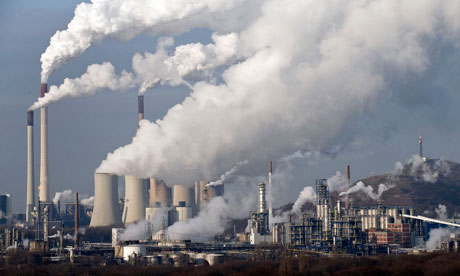What is emissions trading?

Power plants in Europe, such as this coal power station in Gelsenkirchen, Germany, are regulated by an emissions trading scheme. Photograph: Martin Meissner/AP
Emissions trading is a market-based approach to controlling pollution. By creating tradable pollution permits it attempts to add the profit motive as an incentive for good performance, unlike traditional environmental regulation based solely on the threat of penalties.
Developed in the 70s and 80s, emissions trading was introduced in the US in 1990 to combat acid rain, but more recently it has grown in prominence as a way of tackling greenhouse gas emissions linked toclimate change.
The main form of emissions trading is known as "cap and trade": a cap on emissions is set and then permits are created up to the level of this cap. The companies or other entities covered by the scheme need to hold one permit for every tonne of pollution (CO2e) they emit. Allowing a trade in these permits puts a price on pollution – the cost of emitting one tonne of carbon dioxide is the cost of the permit – and creates flexibility as to how and where pollution is reduced.
The theory is that setting a limit on pollution and allowing the market to decide how to stay within that limit is ideally suited to reducing carbon emissions, which come from almost all forms of economic activity and mix into the atmosphere with global effect. The market should ensure that the emissions cuts happen at the lowest possible cost, and the cap can be lowered year by year in a managed way.
Supporters argue that this is preferable to other forms of pricing, such as carbon taxes, which do not guarantee any particular level of reduction. However, critics often emphasise the degree to which emissions trading has been marred by weak caps, free handouts of permits to the biggest polluters and the purchase of "offsets" – carbon credits bought from outside the cap-and-trade system from carbon reduction projects in the developing world.
Emissions trading is a central element of the Kyoto protocol in the form of the Clean Development Mechanism (CDM) and is the cornerstone policy of the EU, whose Emissions Trading System (ETS) is the largest in the world. The expansion of emissions trading was slowed significantly by the US decision to abandon a proposed national policy, although groups of states have set up regional schemes. A number of countries are considering the adoption of some form of cap and trade, including China and South Korea.

